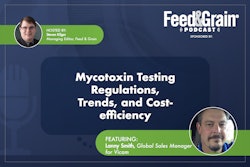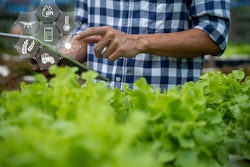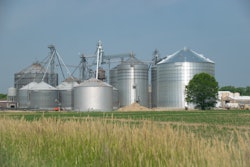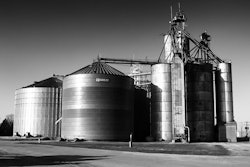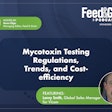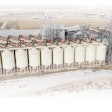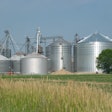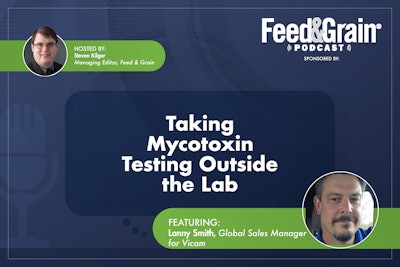
In this podcast episode,Steven Kilger, the host of theFeed & Grain Podcastand managing editor ofFeed & Grain, speaks with Lanny Smith, the global sales manager forVicam. Together they discuss mycotoxins and their impact on the feed manufacturing, grain handling and allied industries.
Smith shares his background and the history of mycotoxin testing, including how Vicam evolved to provide advanced mycotoxin detection solutions. The conversation also covers the costs associated with mycotoxin contamination, both in terms of upfront testing expenses and potential economic losses from tainted products.
The pair delve into technologies and practices for preventing, detecting and managing mycotoxin contamination, highlighting advancements in detection methods, preventive measures like field scouting, and the significance of blending to mitigate contamination.
The episode ends with a teaser for the next part of the conversation, which will explore mycotoxin regulations and emerging testing technologies.
Steven Kilger:Hi, everyone, my name is Steven Kilger. I'm the managing editor for Feed & Grain Magazine and the host of the Feed & Grain Podcast. Thank you so much for joining me today as we dive deep into issues affecting the feed manufacturing grain handling and allied industries. Today, I'm speaking with Lanny Smith, global sales manager for Vicam Waters. We're talking about mycotoxins! My conversation with Lanny is actually going to be split into two parts. This part will go into the history of mycotoxin testing and why grain handlers and feed manufacturers should be testing mycotoxins at the facility. The next part will go into mycotoxin regulations and testing technologies, just to keep these episodes a little bit shorter and hopefully a little bit more digestible.
But before we start, if you're listening to this in a podcast app, please rate us and subscribe. If you're listening online, sign up for the Feed & Grain newsletter, Industry Watch, to see the latest podcasts and stay up to date with all the latest news from around the industry. Now, onto the show.
Hi, Lanny. Thanks so much for joining me today.
Lanny Smith:
Yeah, thanks. I even appreciate you extending the offer to me to come in and talk about some highly talked about topics in the Grain industry.
Kilger:I know mycotoxins it's always more to talk about with them. It's a constantly evolving science. Can you tell me a little bit about you and what you do with Vicam?
Smith: Again, my name is Lanny Smith, and I was born and raised in central Iowa. So I was born in the grain belt, in the agriculture belt, and have a lot of background in agriculture that kind of took me to where I'm at now with Vicam selling mycotoxin test kits to the food and grain industries.
Vicam has been around since about 1985. To give a little bit of insight on the company and mycotoxin testing prior to '85, at that point, I remember this in the grain industry and grain elevator right out of college. We knew there was something in the grain called aflatoxin, and it was basically fluorescence. So they were using black lights to detect it. They really knew what they were seeing. But they knew there was something there.
Vicam, the original owner, went to about five or six major PhDs from all the big colleges, and they kind of put their heads together and said, We got to find out what's going on out there because the original owner from Vicam also owned an egg company up through Maine, New Hampshire, so supplying eggs to the whole east coast, and he could tell us something was going on the hens were not eating, they weren't producing eggs like they should so they finally figured out that there was this toxin or mycotoxin. That's how Vicam developed and our product, easier ways to detect mycotoxins and that was in 1985.
We've come so far since then. Vicam was always in Watertown, Massachusetts. They were purchased by Waters Technologies in 2006. We're part of the Waters Technologies Co. Waters is a big instrumentation manufacturer for laboratories. So, like Agilent, all their suppliers out there and their competitors.
So we sell mycotoxin test kits, immunoaffinity columns that are like a cleanup column that we can take a sample ground up, we flush it through there, we can extract the toxin and put it into a machine, it'll give us part per billion part per million level. So we know what the contamination level is. We can do it by lateral flow, too. One strip, so the antibody is put onto a strip, and we put the solution on it.
Then, that strip is analyzed, and the machine and quantitative numbers are developed there. So that's what Vicam does. And we do it worldwide. We have distributors all over the world. I have three major representatives, one in Latin America, one in Asia, and one in Europe, that manage all these networks of distributors selling our products. And my title is Global Sales Manager. So I kind of manage all that. I also have my own territory here in the US. So I do sell direct to.
Kilger:What's your territory in the U.S.?
Smith:Pretty much everywhere. I live in New Jersey now. I do the whole northern East Coast part, across the United States on the northern and through the Midwest. And then I have all the West Coast, too. We have three people that do all in North America that cover 50 States and Canada, so I also help cover Canada.
Kilger:Well, you're certainly busy. Just that small territory, most of the United States.
Smith:It does get pretty dicey when harvest comes, like what's coming now on getting ready for harvest, and the third and fourth quarters are always our busiest time of the year, the second half.
Kilger:Well, that's a good warning to anyone listening to this: get your orders in now before things really get busy.
Smith:That's right, we're probably coming up on about, probably three, maybe four weeks, probably the end of September or first of October, for corn harvest in the Midwest or all the way through the Corn Belt. The peanut industry is going to start harvesting peanuts probably in about two weeks. The California tree nut industry will start almonds, pistachios, walnuts, and hazelnuts all up and down the West Coast; we'll start harvest probably in about three to four weeks.
Kilger:Well, you're in for a busy month. So, thank you again so much for coming to talk to me.
Smith:哦,不用担心,我喜欢谈论这个。我喜欢education as part of our job, too. It's just not selling. There are always changes in the way we detect mycotoxins, and they, how they grow, where they're at the predominance of each one and, and that's kind of what we report help our customers out and even prospects as far as looking at how they can do this detection.
Kilger:太棒了。因此,真菌毒素总是热的topic issue. And it's quite crazy to believe that only in 1985 did we really start to realize what we were dealing with. So, what are some of the direct and indirect costs associated with mycotoxin contamination for grain elevators and feed producers? What can they potentially stand to lose economically, along with the health risks and all that?
Smith:Sure, I guess the very beginning, you know, talking to a customer, the prospect that wants to, they know that they need to detect this, they need to through regulations through the USDA, FDA saying you need to test it's that cost upfront cost of the instrumentation and then buying the kits. And it is expensive; it's not huge. But then, on the other hand, you look at the expense; if you don't test and they end up with a problem, they end up with an issue, and they can't sell the grain. The grain has to be blended. Something has to be done to get rid of the heavy concentrations of mycotoxins and that grain, whether it be wheat, corn, or barley pulse crops, which is your chickpeas and your lentils, and you have to know where you're at.
Because you're responsible for that product, you're a part of that product, even if you're a grain elevator, and you're the first point of intersection with that, with that grain, are you got to make sure it's safe because you're going to sell it to the next part of the chain, where it's going to go to a Cargills and ADMs of the world processing where they're going to take that corn and make it into corn starch to corn gluten meal to oils, everything. They have to make sure there are not any toxins in there; they have to test again, and on and so on down the line.
So, they look back at where it started. And that's usually at the grain elevators are the feed mills that are buying that grain. So it's very important to start there. Because that cost is the cost of a recall, that's the cost of not being able to sell that grain at the highest quality, especially in the wheat industry where you get vomitoxin, and as you can they use, orders are sorted out, they get the prime grain of wheat can be sold at a higher level. And though the part of the wheat that isn't the best is still sold, it had a lot less price. So you're losing money.
There are a lot of ways where these organizations, whether it be elevators, feed mills, or food manufacturers, can really lose money. So it kind of that thing, oh, do I buy insurance? Or don't I? Do I take the risk? And I always compare it to car insurance, you know, hey, I've driven 30 years, my life never had an accident. I never had even a broken windshield. Why am I paying all this money out every month for car insurance? I could have saved a lot of money. But it takes that one time that you don't have that coverage; you don't have that data to back up when audits come out at some of these locations.
The FDA comes out and says through the FSMA act, you have to be held accountable for the product that you're selling to the next level. And they'll trace it all the way back, and there are fines there, so there are lots of things, I mean, that's getting down to the harsh end of mycotoxin contamination, but it's always lurking, there is it's like any given day, the football game any given day. The upfront cost of it, but then how does that outweigh the cost down the road when a recall or you get shut down? Because you're putting out a bad product or going to like a feed mill to cattle, that kind of thing.
Kilger:Reputational, I imagine that no one wants to be the elevator delivering, like toxin-contaminated grain, and no one's gonna want to buy from you again.
Smith:Exactly. Especially a feed mill, it gets out there that you had, and cattle died, or chickens die, or the reproduction problems of mycotoxins, and it's like, Oh, don't buy from XYZ feed mill because they've had some issues. And that part two gets into the education part. Sometimes people are easy to jump and then go, how come they didn't know that? Well, let's understand the animal first because that's another area of mycotoxins as far as the detection and actually finding it is very hard.
Kilger:Speaking of that, what are some of the best technologies and practices that are available now to prevent, detect, and manage mycotoxin contamination? Even in my time in the industry, which is frighteningly about 11 years now, it's advanced so much from where it used to be.
Smith:It has that tremendously and every day. It didn't, up until probably ten years ago. The reason I use that date is a good 10, well probably farther than that 12-13 years ago, was when lateral flow strip came out. Everybody looks and says, Oh, it's a pregnancy test. Well, that's kind of what it looks like. It's a cassette with a strip inside of it with the antibody sprayed on it. It has come so far.
Like I mentioned earlier, the black light. It was take a tub and put a black light bulb in there and cut some holes and run the grain underneath that. Aflatoxin comes from Aspergillus mold, and Aspergillus mold flourishes. It glows green so you can see it. You can't see it with the naked eye. You put underneath a black light. That's all we really had. Now, is that the actual mold or is that really the aflatoxin?
And mycotoxins, all of them, aflatoxin, fumonisins, vomitoxin, ochratoxin, zearalenone and T-2 are your major six ones, and then M1 gets into milk from aflatoxin. Because they all are derived from a mold, now, the mold can make you sick, whatever. When it converts to the chemical, which is the toxin, which is the aflatoxin, the fumonisins, and there's no getting rid of it. But how do you kill a chemical?
喷在有化学物质cornfields called Afla-Guard; what it does is it's another bacteria that fights the space on the air corn up against the Aspergillus so that it can't grow. So if it can't grow, then your possibilities of aflatoxin are very low. So that's kind of the prevention; there's not a lot. I mean, we're dealing with a natural phenomenon or natural mold that grows everywhere. I always say if we could test a flower, you can probably find that it's got aflatoxin or it's got Aspergillus mold on it. So the prevention is just scouting fields, knowing how the molds grow, you know, aflatoxin or Aspergillus, like heat, like a drought situation. That's why, like right now in the Midwest this year, they're looking because of the high heat and lack of rain and areas that could be some aflatoxin. All the toxins grow differently and come from different molds.
It's just a matter of scouting, knowing, you know, these grain elevators knowing where they're buying their grain from, is there an issue and then having the detection instrumentation to detect and always have it there. So at the beginning era, you know, if you don't find anything, hey, we've got a mild year, then we're good, but there's really no way to get rid of it. Other than blending like in corn or wheat, you can blend it. So if you put a small concentration of aflatoxin corn kernels into a bigger bucket of clean, you're eventually going to you're going to blend it out so that when the final test is, you're below that 20 parts per billion regulation.
There are some areas where the government kind of controls, and that blending is almost what you would call illegal. The individual state government agriculture part of the Government's Department will control that. When it's really bad, they'll allow it just to keep the food chain going. it's just some little practices.
Kilger:Hi, it's Steven. I am butting in just to let you know the rest of the conversation with Lannywill be concluded in the next Feed & Grain Podcast. Make sure you tune in to learn more about mycotoxin regulations and emerging technologies. I can't wait to see you then.

.jpg?auto=format%2Ccompress&crop=faces&fit=crop&h=48&q=70&w=48)




